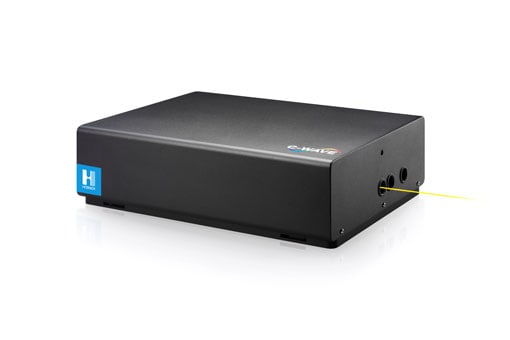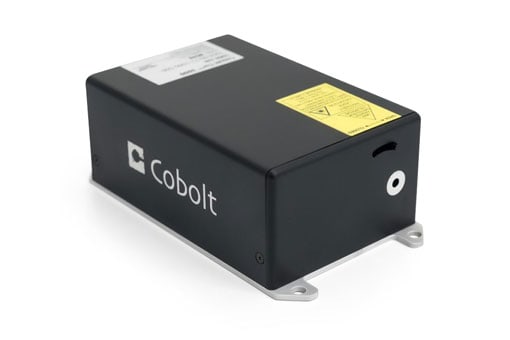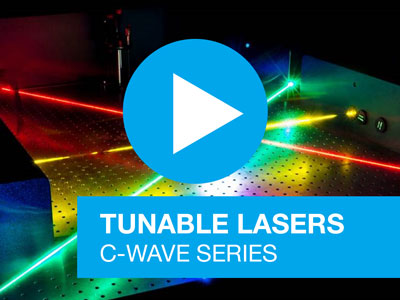What are tunable lasers?
Tunable lasers are laser light sources designed to emit coherent light at large range of wavelengths. Simply put, this ability to “tune” wavelenghts makes these lasers particularly useful in many applications requiring great flexibility and performance optimization. As such, tunable lasers are commonly used for spectroscopy, interferometry, microscopy applications and writing of Holographic Optical Elements (HOE). More recently, we have seen their rise within quantum research.
The challenge of tunability
There exist various types of tunable lasers, each achieving tunability through distinct mechanisms. While these lasers offer notable advantages, attaining and maintaining precise and reliable tunability poses challenges. For instance, one common issue with tunable lasers is their tendency to mode hop, which is the jump between wavelengths as the user attempts to tune the laser. However, aside from mode hopping, other issues that should be accounted for when operating tunable lasers can include mechanical stability, wavelength accuracy, and temperature sensitivity.
In conventional laser setup, a pump source is required, typically a high pump laser, along with a suitable gain medium and placed in an optical resonator to reach the lasing threshold. However, for a tunable laser, selecting an appropriate gain medium with a suitable energy level structure becomes challenging.
For instance, dye lasers cover a broad wavelength range, albeit not with a single dye. This limitation can be inconvenient for applications demanding extensive tunability. Lasers based on Titanium Sapphire crystals cover the red (700 nanometers and longer) and when frequency doubled, the blue (50 to 500 nanometers) in the visible spectrum. Achieving coverage between 500 and 700 nanometers requires frequency mixing with an additional laser beam, resulting in a complex and cumbersome setup. Consequently, choices for conventionally tunable lasers across the visible range are limited, despite the potential benefits in experimental quantum research.
Herein lies the alternative approach from HÜBNER Photonics: leveraging optic parametric oscillators (OPOs) to transform readily available single-frequency laser light into a large wavelength range in the IR and visible range. While the concept of optical parametric conversion is not new and has been experimentally demonstrated for over half a century, recent advancements in high-performance lasers and crystals have facilitated the realization of practical and commercially viable device designs.
Using OPO technology in tunable lasers
At HÜBNER Photonics we have commercialised OPO technology to transform single-frequency laser light into the visible spectrum. OPOs are light sources that deliver coherent radiations similar to lasers but with fundamental technical differences regarding their concept.
OPOs are used to convert one fixed wavelength input laser [OP1] beam of lower wavelength into two separate beams, offering a large range of wavelengths available, usually in the infrared range. After converting these back into the visible range with a Second Harmonic Generation process, OPOs can be used as flexible, tunable sources for laser light in the visible range
OPO technology has the advantage of a very high level of side-mode suppression ratio (SMSR) within just a few cm-1 away from the main peak since there is no amplified spontaneous emission (ASE) in the parametric process, making this technology very well suited to applications such as Brillouin scattering and Raman spectroscopy.
At HÜBNER Photonics we have developed OPO solution for CW & pulsed Q-switched source which cover VIS – MIR wavelength ranges.
Continuous-wave tunable laser
The C-WAVE is the tunable laser light source for continuous-wave (cw) single frequency emission in the visible and near-infrared wavelength ranges. Its technology is based on optical parametric oscillation (OPO) and it is fully computer controlled. Thus, it allows the user to tune from blue to red and into the infrared without any change of dyes or optical components. This makes C-WAVE a flexible and user-friendly laser for your applications. Choose between C-WAVE (VIS & IR), and C-WAVE GTR (VIS & NIR).
Pulsed tunable laser
The Cobolt Odin™ Series is an ultra-compact and industrial-grade mid-IR source based on a fully contained temperature tunable Optical Parametric Oscillator (OPO) with integrated pump laser. Periodically poled nonlinear optical crystals are used for efficient and spectrally flexible generation of mid-IR emission. Available with fixed center wavelengths 3264 nm, 3431 nm, & 4330 nm, tunable 50 nm.
To learn more, browse through our dedicated playlist!
Related products:

C-WAVE Series
Widely tunable continuous-wave lasers
Wavelength: 450 nm – 1900 nm
Power: 200 mW – 1000 mW
Applications: Nanophotonics, quantum research, Raman (TERS)

Cobolt Odin™ Series
Tunable Lasers Mid-IR
Wavelength: 3264 nm – 4330 nm
Power, pulse rate: 60 – 80 mW, 10 kHz
Applications: PAS, LIBS, photoacoustics


